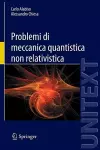
Problemi Di Meccanica Quantistica Non Relativistica
2 authors - Paperback
£29.99
Prof. Carlo Alabiso obtained his degree in Physics at Milan University, Italy, and then taught for more than 40 years at Parma University, Parma, Italy (with a period spent as a research fellow at the Stanford Linear Accelerator Center and at CERN, Geneva), until his retirement in 2011. His teaching encompassed topics in Quantum Mechanics, special relativity, field theory, elementary particle physics, mathematical physics, and functional analysis. His research fields include mathematical physics (Padé approximants), elementary particle physics (symmetries and quark models), and statistical physic (ergodic problems), and he has published articles in a wide range of national and international journals, as well as the previous Springer book (with Alessandro Ciesa), Problemi di Meccanica Quantistica non Relativistica.
Dr Ittay Weiss received his PhD in Mathematics from Utrecht University, the Netherlands, in 2007. He has published extensively on algebraic topology, general topology, metric space theory, and category theory, and has taught undergraduate and postgraduate mathematics in the Netherlands, Fiji, and England. He is currently a Senior Lecturer in Mathematics at the School of Mathematics and Physics, University of Portsmouth, UK. Born in Israel, his first encounter with advanced mathematics was at the age of 16 while he was following computer science courses at the Israeli Open University. So profound was his fascination with the beauty and utility of mathematics that, despite the digital economic boom at the time, he enrolled, as soon as he could, for the BSc program in Mathematics at the Hebrew University and continued to pursue his MSc immediately afterwards, receiving both degrees cum laude. Convinced that the distinction between pure and applied mathematics is illusory and that the abstract and the concrete form a symbiosis of endless mutual nourishment, he finds great joy in digging deep into the mathematical foundations of applied topics. The communication of mathematics is close to his heart. Occasionally he finds an angle he particularly likes, which he might explore in an article in the online journal The Conversation.